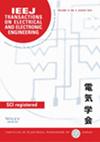Congo Tak Shing Ching, Hsing-Ju Wu, Hoang Anh Pham, Ha Anh T. Nguyen, Ngoc Luan Tran, Hai Dang Nguyen Tran, Minh-Khue Ha, Daniel H. K. Chow, Henry J. H. Chen, Cheng-Chung Chang, Tun Yu Huang, Nguyen van Hieu, Thien-Luan Phan
求助PDF
{"title":"用阻抗和微电极快速鉴定唾液中的葡萄糖","authors":"Congo Tak Shing Ching, Hsing-Ju Wu, Hoang Anh Pham, Ha Anh T. Nguyen, Ngoc Luan Tran, Hai Dang Nguyen Tran, Minh-Khue Ha, Daniel H. K. Chow, Henry J. H. Chen, Cheng-Chung Chang, Tun Yu Huang, Nguyen van Hieu, Thien-Luan Phan","doi":"10.1002/tee.70090","DOIUrl":null,"url":null,"abstract":"<p>Diabetes continues to pose a significant challenge to modern society, impacting not only health but also creating a considerable economic burden. With advancements in healthcare and a growing focus on enhancing quality of life, traditional invasive glucose monitoring methods are increasingly viewed as outdated and uncomfortable. Saliva, as a non-invasive and easily accessible biofluid, has shown a strong correlation between glucose levels in saliva and blood, especially in diabetes patients, presenting a promising alternative for glucose monitoring. Impedance analysis, a technique known for its non-invasive, label-free, real-time, and cost-effective nature, aligns perfectly with the demand for more patient-friendly approaches. This study investigates the feasibility of applying impedance analysis to identify and quantify glucose levels in saliva samples. The findings demonstrate that impedance measurements at 1.19 MHz effectively distinguish between saliva samples with and without glucose, measurements at 480 Hz and 10.1 kHz can effectively identify the glucose sample with concentration as low as 2 mg/dl, while measurements at 85 kHz exhibit a strong correlation (<i>R</i><sup>2</sup> = 0.9959) between impedance values and glucose concentration with a LOD of 1.5 mg/dl. These results suggest that impedance analysis has significant potential as a comfortable, accessible, and reliable method for glucose monitoring, paving the way for improved diabetes management and patient care. © 2025 Institute of Electrical Engineers of Japan and Wiley Periodicals LLC.</p>","PeriodicalId":13435,"journal":{"name":"IEEJ Transactions on Electrical and Electronic Engineering","volume":"20 11","pages":"1901-1906"},"PeriodicalIF":1.1000,"publicationDate":"2025-07-04","publicationTypes":"Journal Article","fieldsOfStudy":null,"isOpenAccess":false,"openAccessPdf":"","citationCount":"0","resultStr":"{\"title\":\"Instant Identification of Glucose in Saliva Using Impedance and Microelectrodes\",\"authors\":\"Congo Tak Shing Ching, Hsing-Ju Wu, Hoang Anh Pham, Ha Anh T. Nguyen, Ngoc Luan Tran, Hai Dang Nguyen Tran, Minh-Khue Ha, Daniel H. K. Chow, Henry J. H. Chen, Cheng-Chung Chang, Tun Yu Huang, Nguyen van Hieu, Thien-Luan Phan\",\"doi\":\"10.1002/tee.70090\",\"DOIUrl\":null,\"url\":null,\"abstract\":\"<p>Diabetes continues to pose a significant challenge to modern society, impacting not only health but also creating a considerable economic burden. With advancements in healthcare and a growing focus on enhancing quality of life, traditional invasive glucose monitoring methods are increasingly viewed as outdated and uncomfortable. Saliva, as a non-invasive and easily accessible biofluid, has shown a strong correlation between glucose levels in saliva and blood, especially in diabetes patients, presenting a promising alternative for glucose monitoring. Impedance analysis, a technique known for its non-invasive, label-free, real-time, and cost-effective nature, aligns perfectly with the demand for more patient-friendly approaches. This study investigates the feasibility of applying impedance analysis to identify and quantify glucose levels in saliva samples. The findings demonstrate that impedance measurements at 1.19 MHz effectively distinguish between saliva samples with and without glucose, measurements at 480 Hz and 10.1 kHz can effectively identify the glucose sample with concentration as low as 2 mg/dl, while measurements at 85 kHz exhibit a strong correlation (<i>R</i><sup>2</sup> = 0.9959) between impedance values and glucose concentration with a LOD of 1.5 mg/dl. These results suggest that impedance analysis has significant potential as a comfortable, accessible, and reliable method for glucose monitoring, paving the way for improved diabetes management and patient care. © 2025 Institute of Electrical Engineers of Japan and Wiley Periodicals LLC.</p>\",\"PeriodicalId\":13435,\"journal\":{\"name\":\"IEEJ Transactions on Electrical and Electronic Engineering\",\"volume\":\"20 11\",\"pages\":\"1901-1906\"},\"PeriodicalIF\":1.1000,\"publicationDate\":\"2025-07-04\",\"publicationTypes\":\"Journal Article\",\"fieldsOfStudy\":null,\"isOpenAccess\":false,\"openAccessPdf\":\"\",\"citationCount\":\"0\",\"resultStr\":null,\"platform\":\"Semanticscholar\",\"paperid\":null,\"PeriodicalName\":\"IEEJ Transactions on Electrical and Electronic Engineering\",\"FirstCategoryId\":\"5\",\"ListUrlMain\":\"https://onlinelibrary.wiley.com/doi/10.1002/tee.70090\",\"RegionNum\":4,\"RegionCategory\":\"工程技术\",\"ArticlePicture\":[],\"TitleCN\":null,\"AbstractTextCN\":null,\"PMCID\":null,\"EPubDate\":\"\",\"PubModel\":\"\",\"JCR\":\"Q4\",\"JCRName\":\"ENGINEERING, ELECTRICAL & ELECTRONIC\",\"Score\":null,\"Total\":0}","platform":"Semanticscholar","paperid":null,"PeriodicalName":"IEEJ Transactions on Electrical and Electronic Engineering","FirstCategoryId":"5","ListUrlMain":"https://onlinelibrary.wiley.com/doi/10.1002/tee.70090","RegionNum":4,"RegionCategory":"工程技术","ArticlePicture":[],"TitleCN":null,"AbstractTextCN":null,"PMCID":null,"EPubDate":"","PubModel":"","JCR":"Q4","JCRName":"ENGINEERING, ELECTRICAL & ELECTRONIC","Score":null,"Total":0}
引用次数: 0
引用
批量引用


 求助内容:
求助内容: 应助结果提醒方式:
应助结果提醒方式:


